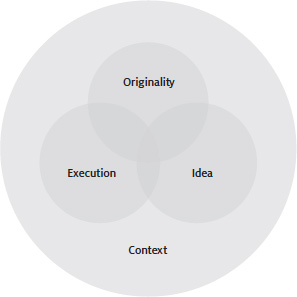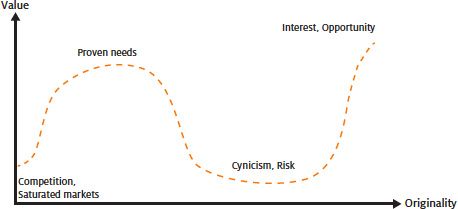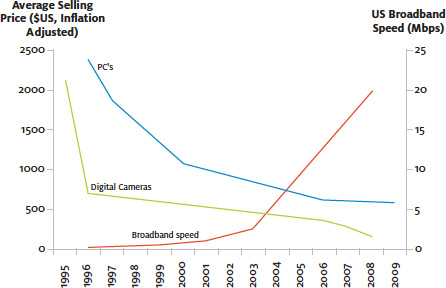This work is licensed under a Creative Commons Attribution 4.0 International License.
You might have an awesome idea that you’ve been contemplating for months and you’ve finally decided to make a start; you might have so many ideas that you never start because you don’t know which one to choose. You might not even have an idea, but you want to know more about the web app creation process.
This chapter discusses the typical characteristics of successful web apps to enable you to appropriately assess and prioritise your ideas and, I hope, to give you some inspiration. By the end of this chapter, you should have confidence in the viability of your chosen app.

There are four interrelated attributes of a web app to consider:
The idea is the reason for and purpose of the app, the task it performs. Ideas are often dangerously misleading because of our limited personal backgrounds, experience and environments: what might be a blinding stroke of genius to one inventor is often of little interest to the wider market.
It’s difficult to gauge whether your web app idea has genuine potential, but you can perform some simple preliminary analysis. First, ensure that you really know what the app’s underlying purpose is. Do this now: write down a short elevator pitch for your app. You might want to use one of these typical structures – they’re a little corny, I know, and overused, but they get the job done.
This should get you thinking about who the target market is and what benefits it brings them. Keep these in mind, and consider the following questions:
The Strategy section of this book delves deeper into this topic: you will be asked to identify a business model for your app, specify user needs, and decide which features are necessary to fulfil them.
The originality of a web app can manifest itself in the idea, if you create an app that does something entirely new. Conversely, a conventional idea can be executed with originality, if you develop a unique interface or underlying algorithm for an app. Google did both of these to disrupt the established search engine market. The following theoretical model illustrates how the originality of an app relates to its perceived value.

At the lower end of originality, the market is saturated with derivative competition, making it difficult to penetrate and generate an impact. Apps in this category might include generic social networks and webmail clients. Nevertheless, you might still decide to create a derivative app, as there’s a good reason for the saturated market: these apps tend to service common user needs, and so the potential customer base, and therefore revenue, is large.
If your web app is unoriginal, focus more of your time on the strategy component in Section 2 of this book. When you enter a highly competitive market you have to get your business model, price points and product/market fit absolutely right.
As originality increases, the competition decreases, but the app still makes a connection with the user based on established needs and existing solutions that they can easily identify with. You can think of these apps as commonplace ideas with a twist. For example, Threadless.com sells t-shirts (a derivative idea) but they allow customers to upload and vote on which designs are sold: that’s the twist. With less direct competition this space is easier to enter.
As originality increases further still, prospective customers lose sight of how the web app solves their known needs and instead they cynically question its utility and desirability. When initially launched, Twitter fell into this category. It wasn’t quite blogging, social networking or instant messaging; its unique mixture of features confused many onlookers.
If your app falls into this category, spend more of your time on marketing the benefits of the app and relating them to existing user needs. Marketing is covered in Section 5 of this book. Luckily for Twitter, the app itself was an inherent form of marketing.
At the far right of the graph, entirely original ideas have absolutely no connection with existing products or known needs, which removes the cynicism, and creates a curiosity and a sense of opportunity. The greatest problem with these apps is that, due to their lack of competition, the market has not validated them.
In other words, why has nobody thought of it before? Perhaps a similar app was launched in the past, but quickly fizzled out due to lack of interest.
If your app falls into this category, devote more time to the strategic user needs analysis discussed in the second section of this book.
The execution of a web app covers every task performed to bring it to market: how well you develop the code, design the interface, price the service and market the benefits. This is the most important factor in the success of your app and is covered in detail in this book.
The context of any web app is the larger environment in which it is situated and it’s the part that you have the least control over. Often misattributed to luck, finding an advantageous context/app fit is mostly about timing.
Whether you realise it or not, there are a number of external influences that affect the success of your app. Let’s run through them.
The web may be global, but most apps are targeted at specific geographical markets, at least when initially launched. These might be explicit (such as a city- or nationwide social network), or implicit (through the choice of language used, for example). Although the geography itself may not be important, the people within the targeted area and their capabilities definitely are. This includes how wealthy they are, how likely they are to spend money online, what speed and type of internet connection is commonly used, and browser and screen resolution factors.
The state of the economy affects all businesses and services, online and offline. If your target users stop spending money because of financial difficulties, your web app will suffer. This can be turned to your advantage, however: in times of belt-tightening, many people turn to the web for better value and for money-saving opportunities such as coupons and comparison apps.
You can’t control the wider market or your competitors, but you can be strategic about how you fit in to the bigger picture and how you’re perceived (this is covered in the Strategy and Promotion sections). Nonetheless, bear in mind how these external forces can influence an app’s success. Many a well-designed web app has been made redundant by the sheer force of a larger enterprise aggressively entering the same market.
As examples of contextual influence, consider Flickr, YouTube and Facebook. Why were these applications successful where many of their predecessors had failed? They were certainly well designed and offered the appropriate features, but the wider context into which each launched was also partly responsible.
Flickr launched in 2004. About two-thirds of the US was online and digital camera prices had fallen every year, resulting in ownership increasing from 30% to 40% of US households in that one year alone1. In the previous year, the broadband speed available to customers had passed 1 Mbps, allowing files the size of typical digital photographs to be more easily browsed online.

YouTube launched in 2005. Most digital cameras were by this point sophisticated enough to include video capabilities and broadband speed had increased to 5 Mbps, which enabled the smooth streaming of video online.
Facebook didn’t open to the public until 2006. Before this, the app was available exclusively to higher education establishments. Unlike the general public, nearly everyone in these institutions had access to the internet, so it was likely that you could connect with your immediate social groups and peers – a key requirement of this type of social application. By 2006, personal computer prices had dropped so low that almost 75% of the US was online. Arguably, this critical mass allowed Facebook to open to the public without fear that a new user would be the sole member of their social group to use the app.
Of course, the context into which an app launches can also be disadvantageous, particularly if the timing or strategy is flawed.
Take kibu.com, which correctly identified the growing online female teen demographic in 2000 and launched a website specifically for this viable market. The website quickly attracted traffic but, even with investment money remaining in the bank, kibu.com was forced to close less than two months after launch. The reason? The dot-com bust: the wider market was collapsing, scaring investors into withdrawing2. The web app was a victim entirely of context.